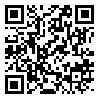

Volume 11, Issue 3 (7-2013)
RBS 2013, 11(3): 157-165 |
Back to browse issues page
Download citation:
BibTeX | RIS | EndNote | Medlars | ProCite | Reference Manager | RefWorks
Send citation to:



BibTeX | RIS | EndNote | Medlars | ProCite | Reference Manager | RefWorks
Send citation to:
هاشمي ت, عبداله زاده جدي آ. Behavioral activation and behavioral inhibition system in borderline personality disorder. RBS 2013; 11 (3) :157-165
URL: http://rbs.mui.ac.ir/article-1-310-en.html
URL: http://rbs.mui.ac.ir/article-1-310-en.html
1- دانشجوي دکتري، گروه روانشناسي، دانشکده روانشناسي و علوم تربيتي دانشگاه تبريز، تبريز، ايران
Abstract: (3558 Views)
Aim and Background: High prevalence of borderline personality disorder and its harmful social, health and economic consequences highlights the importance of studying this disorder and its underlying factors. The present study aimed to investigating behavioral-brain systems of individuals with borderline disorder and its discriminative aspects of these systems in patients and healthy controls. Methods and Materials: Thus 30 patients who admitted to Razi Hospital (Tabriz, Iran), completed the behavioral inhibition system (BIS), behavioral activation system (BAS) questionnaire by Carver and White (BIS/BAS scales). Control group consisted of 30 subjects without any mental disorder history. Findings: Results from multi-variant regression analysis showed that the two groups had statistically significant differences in BAS, BIS and sensation seeking scale (P < 0.01). Among these factors, sensation seeking scale with Wilks’ lambda = 0.42 and BAS with Wilks’ lambda = 0.53 had statistically significant role in discrimination between the two groups. Conclusions: Hyperactivity of BIS caused a permanent anxiety and negative emotions experienced by borderline patients and hyperactivity of BAS could be the underlying reason of impulsivity, which is the core component of borderline personality disorder. According to other studies in the field of bio-neural factors effects in development of borderline personality disorder, this study can help to improve our understanding of disorder and therefore help to improve developing accurate methods to predict the possibility of disorder. In addition, it will help us to develop methods for primary prevention and developing more effective therapy methods.
Keywords: Gray&, #039, s reinforcement sensitivity theory, Behavioral activation system, Behavioral inhibition system, Borderline personality disorder, Impulsivity
| Rights and permissions | |
 |
This work is licensed under a Creative Commons Attribution-NonCommercial 4.0 International License. |



